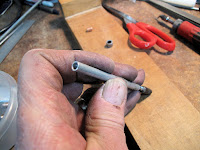The Drag and Anti-Drag wires which hold the wing rigid are made of 0.125" Piano Wire and attached to brackets called Wire Clips. To protect the wire, a copper eyelet is formed in the wire hole of each clip. It gives a round edge to the hole and more surface area for the wire to bear against. On cable we use an AN-100 thimble. I assume this eyelet was a carry over from WWI because they used AN-100 thimbles on all the external cables bracing the wings, etc. Thimbles seem like they would work fine for these wires, but I'm having fun making eyelets, so onward.
I first considered 1/4" diameter, 0.035" wall thickness, soft copper coil stock, which makes a beautiful eyelet. However the drawing calls 1/4" x 0.049" hard drawn tubing. I ordered four 12" lengths from OnlineMetals.com
I got 4 pieces because they were only $2.67 each and it allowed me to cut off 8 ends at a time to make the 24 eyelets.
I started by lightly grinding the ends square while rotating them. It makes a nice square end. Then deburr the ends.
The drawing says to make them 9/32" long so I made a gauge bushing from a piece of 4130 tubing that fit nicely over the copper tubing. Both ends were lightly ground square, as above.
The bushing was used to mark a ring around the ends of the pieces of tubing, 9/32" from the end, with an Exacto Saw. It just needs to be deep enough to see while cutting off the piece of tubing and grinding the end square.
I cut the copper pieces off with the metal cutting band saw. Slowly rotate the tube while cutting. I cut almost all the way through, leaving a tiny tab connecting them. Then break the piece off. It's better than hunting around the floor for them.
Next I needed a way to hold the pieces while grinding the sawn edge square. A 3/16" masonry drill bit, some Gorilla tape and a piece of 1/4" aluminum tubing worked perfect. Obviously I could have used a piece of the copper tubing.
The idea was to leave an end sticking out about 1/4" to hold the piece of copper.
It makes it like holding the original tube while grinding the end square and to the marked line. Simple.
You can also use the holder while deburring the outside edge of the piece with a mill file.
This whole idea came from repairing some Piper Cub wing ribs using Mil Spec. 3/32" semi-hollow steel rivets. That's what they used at the factory and it works way better than solid aluminum rivets.
I went to Hanson Rivet & Supply Co. and ordered 2 of their CA2005-29 1/4 Long Squeezer Die For 1/4 Diameter Tubular Rivet. That's a mouthful.
I figured if you put one at each end of the tube they would form rolled over ends just like on the rivets. It works great. They fit my hand held rivet squeezer, which I clamped in a vice.
You center the tube in the fitting and squeeze to form a beautiful eyelet. Oh yeah, squeeze hard. The factory probably did this with an arbor press or some such.
They look like the original. Theirs may have rolled the edge a little more, but they should protect the wire and stay put. There is no motion to make them ever move, if they could.
More parts done. I did find the tubing O.D. slightly (0.002") over 1/4" so they won't fit in a 1/4" hole. I used a 17/64" drill but a letter B size leaves a little clearance for paint,etc. and works fine.
Now I need to straighten a coil of 1/8" piano wire to make the drag wires.




























No comments:
Post a Comment